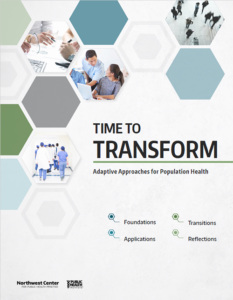
Study & Toolkit: How Local Health Departments Can Transition to Population Health Approaches
-
Focus Areas
Capacity Building & Leadership, Health Care & Population Health -
Issues
Population Health -
Programs
Population Health Innovation Lab (PHIL)

The expansion of health care coverage across the United States over the past decade coincides with a growing awareness of the impact that the social determinants of health play in shaping healthy communities. Identifying the right connections, partnerships, and resources while embarking on successful interventions in this new terrain is a difficult but essential role for local health departments (LHDs). The scale and complexity of this challenge requires LHDs and their partners to develop a systems-level strategy to meet the needs of an evolving service model.
Created in part by PHI’s Population Health Innovation Lab, this study and toolkit help LHDs transition from direct clinical services to population health-focused approaches, in order to maximize their role in population-focused strategies and improve community health.
Read the full study, "Time to Modernize"
Download the "Time to Transform" toolkit
STUDY: Time to Modernize: Local Public Health Transitions to Population-Level Interventions
Using key informant interviews, this study identifies common characteristics and strategies, and shares replicable solutions, practices, and methods that enable successful transitions of LHDs toward maximizing their role in population health. Researchers found that strong relationships and open communication with community members and partner organizations (eg, federally qualified health centers) were critical facilitators of transition, and themes from interviews were used to identify an initial set of eight key elements of an effective transition: partnership/leadership, vision/goals, communication, community engagement, interventions, data/evaluation, workforce issues, and sustainability.
This study was authored by Suzanne Ryan-Ibarra, Holly Nishimura, Kyli Gallington, Sue Grinnell, and Betty Bekemeier.
Read the full study, "Time to Modernize"TOOLKIT: Time to Transform: Adaptive Approaches for Population Health
In collaboration with the Northwest Center for Public Health Practice, PHI’s Population Health Innovations Lab developed the Time to Transform toolkit. Created as a guide for local health department teams currently in the process of or preparing to evolve towards population health services, this toolkit integrates recent research in the field of population health practice: from key informant interviews conducted with leaders from seven LHDs, to findings collected from a Learning Laboratory community of practice comprising 5 LHDs from across the US.
This toolkit is intended to be a tool for collaboration, consensus-building, and creative sharing, and the key learning goal of this toolkit is to crystalize knowledge and practice through an iterative process—revisiting past work and anticipating that which lies ahead, with an aim for quality improvement.
Work With Us
You change the world. We do the rest. Explore fiscal sponsorship at PHI.
Support Us
Together, we can accelerate our response to public health’s most critical issues.
Find Employment
Begin your career at the Public Health Institute.



